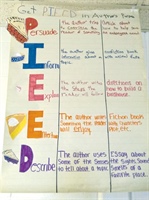If you asked my students whether they do a research paper in my seventh grade English class, they would probably say “no”—not because they don’t do research, but because they don’t do research and write about it in the traditional manner. The same would probably be true if you asked them about informative, argumentative, or any other kind of writing.
Why? Blogging is my students’ writing platform, and they enjoy writing and connecting with others about their topic so much that it no longer feels like a writing assignment. They are real authors in the real world.
The Common Core State Standards (CCSS) encourage students to incorporate technology into the writing process and call on teachers to have students write for a range of purposes, allowing them time for research, reflection, and revision. I can think of no better way to do this than through blogging. Blogging has opened unlimited opportunities for my students to explore topics that matter to them. It has brought my readers’ and writers’ workshop into the 21st century.
Getting to Know You

A heart mapping activity prompts students to explore their personal interests as they prepare to blog.
At the beginning of the year, I use Nancie Atwell’s heart mapping activity (see her book, Lessons that Change Writers) to explore students’ interests. We brainstorm and discuss what really matters to us in this world. Students write about those things that are important to them inside the drawn shape of a heart, with the most important things in the center. We talk about why these things are important and while we talk, I point out patterns I see in their brainstorming—common themes like sports, crafting, baking, family, and friends.
When we’ve had ample time to get to know one another and our brainstorming has been exhausted, I show the students mentor texts—magazines pertaining to special interests such as photography, cooking, baseball, and the outdoors. These mentor texts not only provide examples of specific writing skills, they also get students thinking about their own personal special interests.
We also look at blogs as mentor texts. Students explore a variety of blogs, looking for patterns in the way the bloggers use digital media and text, hyperlinks, and comments. We talk about the blogs that appeal and don’t appeal to them. I share my blog (http://jmliteracy2.blogspot.com) and we talk about why I like to blog.
This is the exploratory phase in the blogging process—a crucial step that should not be dismissed. With so much required curriculum in a year’s time, it may be tempting to abbreviate the time used with mentor texts. However, remember that before students can be writers themselves, they need to see how and what other people write about in the real world—in print and digital media formats.

Students chart the main purposes of writing, which helps them focus their writing and practice their skills.
After we have discussed the various types of writing they encountered in the mentor texts, such as informative, descriptive, and argumentative, students create a wall chart defining each type of writing and provide examples of mentor texts that illustrate each type. This chart guides them throughout the school year as they write for different purposes—something I encourage them to do each time they blog.
This is a great time to use mini-lessons to focus on each of the writing types. I divide students into small groups according to their writing purposes, which allows me to offer direct instruction and guidance about the idiosyncrasies of each of the types of writing formats they may be working on at any given time. Throughout the year, I meet with the students on a regular basis to evaluate their writing skills, research skills, technology skills, and even grammar. Then, I use mini-lessons to address their needs.
When you teach this way, it is hard to plan in advance. You must constantly evaluate and reevaluate. Being flexible is a must! You may sketch out a general road map, but your students should always guide the turns you make.
Beginning the Blog

In their first blog, students introduce themselves and share their interests.
When I think the students are ready, they begin drafting their own blogs. Their goal with the first blog is to write an introductory blog about themselves. As they draft their first post, and as they continue to post to our classroom blog all year, I conduct mini-lessons on how to find and cite reliable sources on their topics, how to hyperlink, how to embed images and video, and how to “chunk” (paragraph) their text to make it reader-friendly. Other topics include how to write a title that catches a potential reader’s attention and the importance of proper grammar. It’s good to remind students that they will have an audience much larger than just the teacher reading their posts.
Blogging provides students with an authentic audience. Depending on your comfort level, you can adjust the settings for your student blogs to allow for a true global audience, or you can be more restrictive and allow only students in your class, school, district, and/or parents to view and comment on your students’ blogs. The choice is yours to make, but I encourage you to opt for the true global audience; students are eager to share their thoughts with an audience beyond their community.
Read and Respond

Students learn how to comment appropriately and thoughtfully about their classmates’ blogs.
When students are working through the revision and editing process, it is time to get them excited about reading each other’s posts. Before allowing students to read and comment on blog posts independently, I model my own reading of a blog post to my class. I think aloud as I read, then with my students watching, I scroll to the comment box on the blog. There, I model how to write a well-thought-out comment that demonstrates both comprehension of and reflection on what I just read aloud. This is time well spent; you don’t want to get a hundred blog comments with smiley faces, “great job,” and “OMG.”
I allow time at the beginning of the year for peer reading of blog posts, but I encourage students to read their classmates’ blogs outside school as well. Blogging can help build community, as it provides students the opportunity for reading and writing outside the classroom.
Team with teachers at the other grade levels and ask their students to comment on your students’ blogs. It is also fun to have comments from administrators, such as the principal, assistant principal, special education director, superintendent, and school board members. There is nothing more validating and motivating than seeing a positive comment on your blog posts.
Supporting the Standards
Does this instructional strategy sound inquiry-based to you? It should! I am teaching the CCSS while allowing students to explore topics of their choice using technology. My students research and explore topics of personal interest to them, synthesize what they read, then write about it in their own blog posts. Students connect with experts online and collaborate with other bloggers to create dynamic text. My students are learning much more than English; they are learning to be active participants in their own education.
The Common Core State Standards ask students to write for a range of purposes, and they require teachers to incorporate technology in the classroom. Blogging accomplishes these goals while allowing for student choice, which is so critical at the middle school level.
If we want students to be prepared for the “real” world, we have to provide opportunities for them to practice for the real world. Blogging is real-world writing for an authentic audience. It doesn’t get any better than that!
Jamie Diamond teaches seventh grade English at Prairie Middle School in Barrington, Illinois. She co-authored the book Literacy Lessons for a Digital World with Meg Gaier (Knapik), and also is an adjunct professor at Judson University in Elgin, Illinois. jdiamond@barrington220.org
Published in AMLE Magazine, November 2015.

Hello!
I really like this idea of using blogs in the classroom. I feel like this is an excellent creative outlet for students, especially for those who either have their own blogs, to begin with or have always wanted to start one.
Hello! Thank you for this deep insight into blogging! Incorporating technology is super important to me, and this article provided reasoning and strategies as to incorporating blogging into classrooms. In my science and math classes, I can definitely see a benefit to using blogs to help students interact with content on a more creative and deeper level. Thank you!:)
Incorporating technology into the classroom is definitely something that we have been introduced to this year and it is something that I hope stays long after COVID-19 is gone. We can utilize technology in a way to reach students that we never could with just pencil and paper. I absolutely love this idea of blogs! It allows students to be more involved than just in a discussion board as many of those are repetitive, but this gives students creative freedom.
Hello! I really enjoyed reading what your article has to offer. I think that it is extremely important for students to have opportunities to write in class, but incorporating technology and activities such as blogs or “posts,” where students can have meaningful discussion, is very interesting. I can really see the potential for having an activity like this in both my English Language Arts and Mathematics classes.
Hello!
I enjoyed reading this post. I think adding blogging to the classroom is a great idea. There’s so many hobbies students have that can be utilized in an educational context. I can really see an interschool blog being a great way for students to share their interests with eachother. And teaching them how to be responsible bloggers and commenters is a skill they’ll carry with them outside of the classroom and throughout life.
Incorporating technology into the classroom is something that has been looked at through a different lens since the pandemic. By having it be something that teachers have had to embrace and incorporate, I hope it continues to stay long after COVID-19 is gone. Utilizing technology allows students to reach audiences that we never could with traditional mediums. It also allows students to engage in a type of creative freedom that is unique to blogs.
Hello! I thoroughly enjoyed reading this article and agree that blogging is a great option for letting students write. There is so much pressure on students to sit down and write formal essays; however, they can accomplish the same goals with blogging. I like the point you make that they are “authors in the real world.” Blogging not only allows students to put technology to use, it also allows them to connect with others all around them. They can also learn writing techniques and other skills listed in their academic standards while getting a chance to write in a unique, creative way!
I love this concept! Having students blog for their form of writing is a pressure free way to have students writing a lot more than they traditionally would. It is super important that the students understand what a blog is and are aware of your expectations for them when it comes to this type of writing. This is demonstrated in the article when you talked about modeling writing the blog itself and example responses. This is also a very cool way to have students interact with their peers writing.
I love the idea of incorporating “blogs” into the classroom, especially in a history classroom. This allows them to practice writing but not have the pressure of an essay. This will also allow them to practice blogging in school and understand the expectations of it. I could incorporate this into the classroom by having a ‘classroom’ blog for assignments.
I love the idea of incorporating “blogs” into the classroom, especially in a history classroom. This allows them to practice writing but not have the pressure of an essay. This will also allow them to practice blogging in school and understand its expectations. I could incorporate this into the classroom by having a ‘classroom’ blog for assignments.
I’m an aspiring educator, and I find incorporating blogging into the classroom inspiring. It seems like a practical way to connect students with ‘real-world’ writing and to implement essential skills such as critical thinking and digital literacy. I’m interested in exploring how blogging can align with curriculum standards while providing a creative outlet for students to express their thoughts and engage with a broader audience.